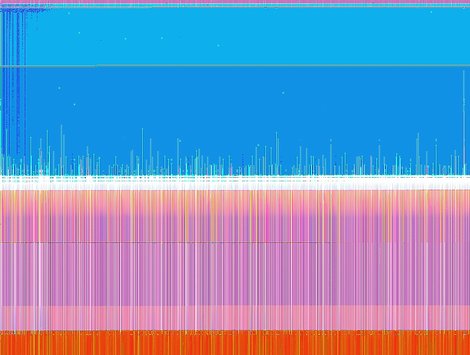A collection of Images produced by intentionally corrupting the circuitry of a Kodak DC280 2 MP digital camera.
Full Description
The DCP Series of Digital Images are direct visualizations of data generated by a digital camera as it takes a picture. Electronic processes associated with the normal operations of the camera, which are usually taken for granted, are revealed through an act of intervention. The camera is turned inside-out through a complex of short-circuits, selected by the artist, transforming the camera from a picture taking device into one that renders raw data (electronic signals) as images. In essence, these images are snap-shots of electronic signals dancing through the camera's circuits, manually rerouted, written directly to the on-board memory device. Rather than seeing images of the world through a lens, we catch a glimpse of what the camera sees when it is forced to peer inside its own mind.
Work metadata
- Year Created: 2011
- Submitted to ArtBase: Tuesday Jan 25th, 2011
- Original Url: http://www.flickr.com/photos/phillipstearns/sets/72157624890444969/show/
-
Work Credits:
- phillipstearns, primary creator
Take full advantage of the ArtBase by Becoming a Member
Artist Statement
In my work, the circuit functions as a tool for sculpting and directing the flow of electricity, and consequently has the capacity for embodying forms of expression on a depth of levels. At the site of mediation, where expression is funneled down into eddies within the flow of electric current, the choice of how to translate that energy back into an output becomes a vehicle for meaning. Translation indicates a choice, one of representation, and thus remains open to subjective interpretation. The output is crucial; it is the means by which we experience the electrical activity within the circuit and the process of translation from the abstract to the phenomenological. That it communicates information---be it purely expressive, factual or otherwise---places it within the definition of media. A consequence of this translation from one mode of symbolic representation to another is that a myriad of choices is revealed. The following are but a few that I consider in creating electronic work:
* What phenomenon do we convert in to electric signals?
* How are phenomenon represented in terms of voltage and current?
* What types of translations are to be made between mores of representation?
* How is the information translated back into the realm of the phenomenological?
* How does the system interface with its environment?
It is precisely these choices that open avenues for artistic exploration of alternative modes of experience and expression. Interactive electronics necessarily entail several forms of mediation. The nature of mediated reactions, because it is determined in part by the circuit and system design, thus become raw material for my practice as an electronics artist.
